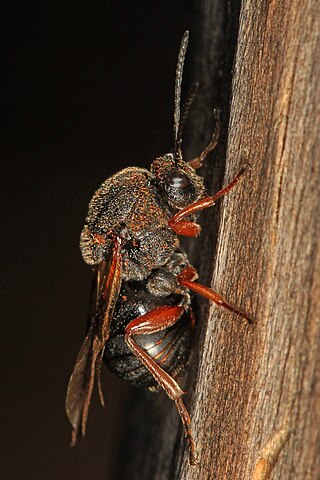
Gall wasps, also traditionally calledgallflies, are hymenopterans of the family Cynipidae in the wasp superfamily Cynipoidea. Their common name comes from the galls they induce on plants for larval development. About 1,300 species of this generally very small creature are known worldwide, with about 360 species of 36 different genera in Europe and some 800 species in North America.

Neuroterus is a genus of gall wasps that induce galls on oaks in which the wasp larvae live and feed. Some species produce galls that fall off the host plant and 'jump' along the ground due to the movement of the larvae within.

Cynips is a genus of gall wasps in the tribe Cynipini, the oak gall wasps. One of the best known is the common oak gall wasp, which induces characteristic spherical galls about two centimeters wide on the undersides of oak leaves.

Andricus is a genus of oak gall wasps in the family Cynipidae.

Cynipini is a tribe of gall wasps. These insects induce galls in plants of the beech and oak family, Fagaceae. They are known commonly as the oak gall wasps. It is the largest cynipid tribe, with about 936 to 1000 recognized species, most of which are associated with oaks. The tribe is mainly native to the Holarctic.
Aphelonyx kordestanica is a gall wasp species in the family Cynipidae whose life cycle involves only Palaearctic oaks, Quercus subgen. Quercus, in the section Cerris.
Synergini is a tribe of gall wasps in the subfamily Cynipinae.

Feron kingi, the red cone gall wasp, is a species of gall wasp in the family Cynipidae.
Synergus japonicus is a species of gall wasp in the family Cynipidae. Whereas most gall wasps create the galls in which they live, Synergus japonicus is an inquiline species, living in the gall created by another species of wasp. It is native to Japan, China and Russia.
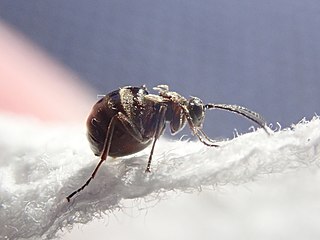
Acraspis quercushirta, the jewel oak gall wasp, is a species of gall wasp in the family Cynipidae, tribe Cynipini, found in North America.
Antron is a genus of gall wasps in the tribe Cynipini, the oak gall wasps. Some authors have included it within the genus Cynips but it was recently resurrected. The genus was established by Alfred Kinsey in 1930.
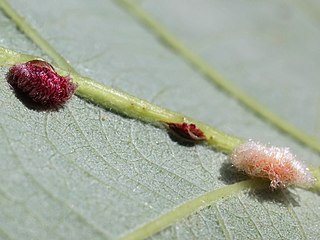
Druon is a genus of gall wasps in the family Cynipidae. The type species is Druon protagion. Recognised species include:
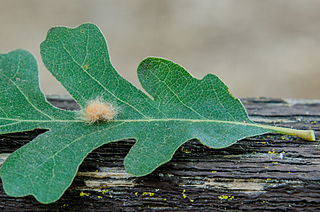
Druon fullawayi, also known as the yellow wig gall wasp, is a species of gall wasp in the family Cynipidae. It was previously placed in the genus Andricus. William Beutenmüller described the female adult wasps as 1.5-2.25 mm long, black with brown mouth parts and brown legs. The galls of D. fullawayi are tan or yellow, woolly, and measure 5-8 mm in diameter. Each gall holds a single chamber for larvae. They are found in California on oak trees, especially Quercus lobata.

Feron crystallinum, also known as the crystalline gall wasp, is a species of gall-forming wasp in the genus Feron. Its galls are pink and covered in hairs that are white, red, or brown. These galls are often massed together in clumps that can cover the underside of leaves. Individual galls are 12-14 mm high, 7 mm across, and have a single chamber for larvae. The unisexual female generation emerges in late winter, and the bisexual generation of males and females emerges in March. They are found in all species of oaks in California.

Feron parmula, also known as the disc gall wasp, is a species of oak gall wasp in the genus Feron. It induces galls in a wide selection of oak species, especially white oaks, and including hybrids. The galls are disc-shaped, up to 3 mm in diameter, and pale with red streaking. Adult females emerge in April. The galls induced by F. parmula superficially resemble the galls of Feron gigas,Andricus viscidus, and newly identified species called the "plate gall wasp" and the "orange-cap gall wasp" by Richard Russo. Galls induced by this wasp have been documented in Oregon and California on the Pacific coast of North America.

Feron gigas, also known as the saucer gall wasp, is a species of gall-forming wasp in the genus Feron. It induces galls on the leaves of scrub oaks, blue oaks, and Engelmann oaks. The galls produced by its all-female generation, which emerges in winter, are 3-4 mm wide, circular with raised edges. They are red, pink, brown, or purple. The larval chamber exists as a raised bump in the gall's center. The bisexual generation produces galls that are brown and cone-shaped.

Feron pattersonae, also known as the plate gall wasp, is a species of oak gall wasp in the genus Feron. Their hosts are among the white oaks grouping of oaks, with blue oak being common.
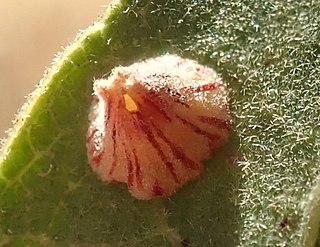
Feron atrimentum, also known as the striped volcano gall wasp, is a species of gall-forming wasp in the genus Feron. It induces galls on blue oak leaves. Like other oak gall wasps, it has two generations: a bisexual generation, and a parthenogenic female generation. The bisexual generation produces round, 3–4 millimetres (0.12–0.16 in) galls in spring that start as green or pink, and then turn brown. The unisexual generation produces conical, 4–4 millimetres (0.16–0.16 in) galls in summer that are pale with red stripes.

Feron bakkeri, also known as the pinched leaf gall wasp, is a relatively uncommon species of gall-inducing hymenopteran. They produce pink leaf galls on Oregon oaks and scrub oaks. The distribution of this wasp is California and Oregon in North America. It was previously placed in the genus Andricus.














